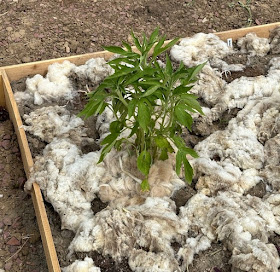 |
| Snowy Tree Cricket (Oecanthus niveus) Photo: Caleigh Ryan-Melville |
Part of a larger order called Orthoptera, Oecanthus niveus are omnivorous creatures, feeding on leaves, fungi, fruit, and smaller insects, such as aphids [5]. Their chewing mouthparts create damage on leaves that appears as though a bite has been taken out of them.
While snowy tree crickets aid home gardeners by eating aphids, they are actually a household pest due to their habit of eating fabric. To prevent crickets from entering the home, maintain weeds in ornamental beds, keep piles of wood or rock away from the home, seal cracks around the foundation, and ensure there are no spaces at the bottom of exterior doors. If a cricket does enter the home, it can be vacuumed [1].
 |
| Snowy Tree Cricket (Oecanthus niveus) Photo: Caleigh Ryan-Melville |
Female Oecanthus niveus have a narrower body, while males have a rounder abdomen. Males have a marking along their posterior abdomen that consists of three lines that look like a diagonal, upside-down F. Based on the abdomen shape and marking, the cricket in my yard appears to be a male [4].
Oecanthus niveus has one of the identifiable characteristics for insects in the class orthoptera: long, “hind legs modified for jumping” [2]. A common characteristic of the Gryllidae family that is shared by the snow tree cricket is the antennae that are as long as the body (if not longer.) This family consists of “true crickets,” and they are the only family capable of maintaining constant pitch to communicate with other cricket [3].
 |
Male.
|
Drawing by B. B. Fulton (from Plate V, c, Fulton
1915). |
During my deep dive into the snowy-tree
cricket, I was interested to find that they are also known as the “thermometer
cricket” since the frequency (or speed) of their chirps change with their
temperature. The recordings on the Orthopterist Society’s website (linked here) demonstrate that the
chirps become more frequent in warmer weather than cooler weather. You could
actually do some math to use the number of chirps per minute as a measure of
outdoor temperature [4].
References
- Colorado
State University. (2015). Colorado
pest identification handbook (8th ed.). Retrieved September 29, 2024,
from https://webdoc.agsci.colostate.edu/ipm/Colorado%20Pest%20ID%20Handbook%208-18-15.pdf
- North
Carolina State University. (n.d.). Order
Orthoptera. Retrieved September 29, 2024, from https://genent.cals.ncsu.edu/insect-identification/order-orthoptera/
- North
Carolina State University (n.d.) Family
Gryllidae. Retrieved September 29, 2024, from https://genent.cals.ncsu.edu/insect-identification/order-orthoptera/family-gryllidae/
- Orthopterist
Society. (n.d.) Snowy Tree Cricket.
Orthopterist Society. https://orthsoc.org/sina/585a.htm
- University
of Wyoming. (n.d.). Oecanthus niveus
(DeGeer). Retrieved September 29, 2024, from










